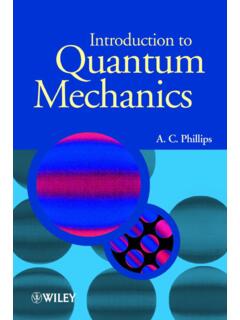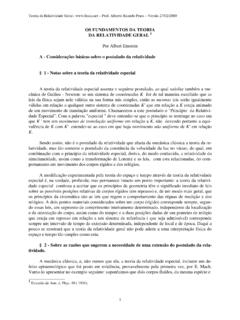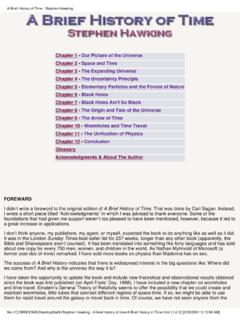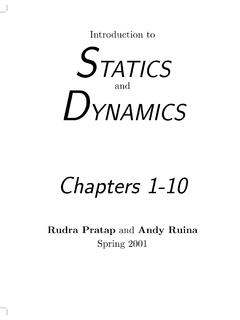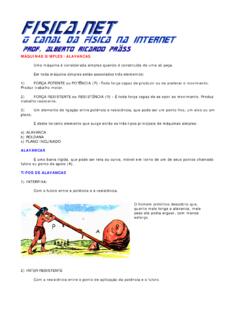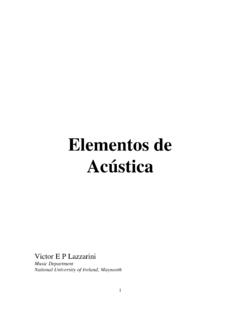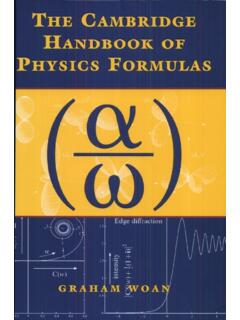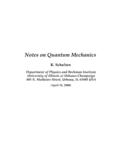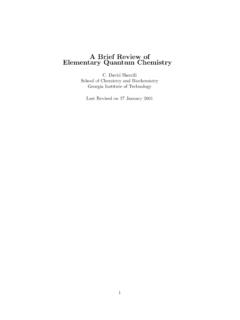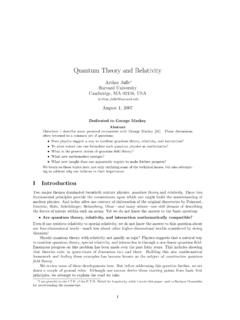Transcription of The Quantum Harmonic Oscillator
1 The Quantum Harmonic OscillatorStephen WebbThe Importance of the Harmonic OscillatorThe Quantum Harmonic Oscillator holds a unique importance in Quantum mechanics, as it is both oneof the few problems that can really be solved in closed form, and is a very generally useful solution, both inapproximations and in exact solutions of various Harmonic Oscillator is characterized by the Hamiltonian: H=P22m 12m 2X2 This Hamiltonian appears in various applications, and in fact the approximation of the Harmonic oscillatoris valid near the minimum of any potential function. Expanded around a minimum point x*, any potentialcan then be Taylor expanded as:V x =V0 x x* V x x=x* 12 x x* 2 2V x2 x=x* In this case, V0 is an arbitrary constant that can be taken to zero, and the second term is zero since thederivative is zero at critical points.
2 If we assume that the variation around the critical point is small, then thehigher order terms may be neglected, and we may readjust the variables to place the critical point at 0 andapproximate it as a Harmonic Oscillator also gives the exact solution for a particle in a uniform magnetic field of agiven vector potential, as that vector potential merely takes the form of a two-dimensional , it serves as an excellent pedagogical tool. It introduces people to the methods of analyticallysolving the differential equations frequently encountered in Quantum mechanics, and also provides a goodintroduction to the use of raising and lowering operators, and using the abstract vectors that are frequentlyused in Quantum mechanics to solve problems by knowing the action of operators upon state vectors, ratherthan using integration to evaluate expectation Classical Oscillator : A ReviewThe classical Harmonic Oscillator is most frequently introduced as a mass on an undamped Hamiltonian for such a system is:H=p22m 12kx2and from the canonical relations we find that.
3 H p= x=pm H x= p= kxSolving this set of differential equations then gives the solution:x t =x0cos kmt It is this solution that we should approximately get in the high energy limit solution to the quantumharmonic Oscillator , and this will be our test that we have found the solution to the Quantum Harmonic Oscillator : Analytical SolutionWith the Quantum Harmonic Oscillator we are presented with the problem of finding theeigenfunctions of the given Hamiltonian, which, in the position representation, is: H= 22m 2 x2 12m 2x2 The Schrodinger equation then reads: 22m 2 x2 12m 2x2 = i tThis is a second order, nonhomogeneous differential equation, for which we may apply separation ofvariables to turn it into the standard time independent Schrodinger equation: 22m 2 x2 12m 2x2 =E Our first instinct in solving this problem should be to use a power series solution, as we know thatthe wave functions must be well behaved enough to be expressed as a power series, and the problem itselfdemands the use of it.
4 First, we get the problem in unitless dimensions, doing so by making the followingsubstitutions and dividing through by constants: =E y= m 1/2xMaking these substitutions, we then get a unitless differential equation: '' 2 y2 =0To find the solution to this differential equation, we first analyze its asymptotics, that is, the extremepositions of the differential equation. In this case, we look at small energy, when the y^2 term dominates. Inthis form, the differential equation is approximately: ''=y2 which suggests that the wave function may be a Gaussian, or something of similar form. Thus, we guess thatthe wave function is of the form: x =u y exp[ y2/2]Plugging this into the differential equation we get:u'' y exp[ y2/2] 2u' y yexp[ y2/2] 2 1 u y exp[ y2/2]=0We can get rid of the Gaussian terms, as they represent a general multiplying factor, thus:u'' 2yu' 2 1 u=0If we assume that the equation for u is in the form of a power series, we make the substitution:u y = n=0 Cnyn n=0 Cn[n n 1 yn 2 2nyn 2 1 yn]=0 Analyzing the resulting series solution, we arrive at the recursion relation:Cn 2=Cn 2n 1 2 n 2 n 1 In theory we've solved the problem, except for the normalization condition.
5 In the limit of large n, we findthat the ratio between the succeeding terms is n/2, which grows faster than the terms in the exponential. Thisseries diverges faster than our Gaussian converges, and the only way for the series to converge, and thus forthe wave function to have any physical meaning, is for the series to truncate. The best way to do this is tomake the numerator zero, as any successive terms to that would be zero as well, and from this we get:2 =2n 1 =n 12 E= n 12 From the requirement that the power series converge, and therefore truncate, we find that the energylevels for the Harmonic Oscillator are power series solution is not complete, as the individual eigenstates of the Hamiltonian are notyet made orthogonal.
6 When this is carried out, what results is a solution that involves the Hermitepolynomials, and is of the form: n x = m 1/41 2nn!Hn[ m 1/2x]exp m 2 x2 The computation of expectation values with this involves knowledge of the Hermite polynomials,and involves integrals of Gaussians that become tedious and leave open the possibility for algebraic error. Italso does not take much advantage of the tools of linear algebra that can be applied to Quantum alternative method, developed by Paul Dirac, utilizes a different method, in which the Hamiltonianis factored into raising and lowering operators to acquire the different eigenstates of the Hamiltonian, andwill be discussed Quantum Harmonic Oscillator : Energy Basis MethodThe first thing to do is to generate a unitless form of the Hamiltonian, which we do by introducing anew operator.
7 H' =HThis makes the new operator measure the energy states in terms of the characteristic energies, andremoves several constants that would otherwise appear in the process of solving the problem, and such asubstitution is made with a priori knowledge of the results that are to substitution the makes the new Hamiltonian operator:H'=P22m 12m X2We now introduce two new operators, what we will eventually recognize as the raising and loweringoperators:a= m 2 1/2X i 12m 1/2Pa = m 2 1/2X i 12m 1/2 PThe new Hamiltonian operator we created can be expressed in terms of these operators as:a a=m 2 X2 12m P2 i2 [X,P]a a=H' 12 H'=a a 12 These operators then satisfy the commutation relations[a,a ]=1[a,H']=a[a ,H']= a Such commutation relations we will find useful, and these relations indicate that these operatorsproduce new eigenstates of the Hamiltonian:H'a n = aH' [a,H'] n H'a n = aH' a n = n 1 a n The indication of this is that the operator a, which we will now refer to as the lowering operator,generates some new eigenstate for the Hamiltonian, which is one energy level below the previous, to withina normalization constant.
8 A similar procedure can be done to show thata has a similar effect, onlyraising the eigenenergy of the here we have a mechanism for determining all future eigenstates of the Hamiltonian given onlyone of them. Theoretically we have the capacity to generate an infinite number of energy states just byrepeatedly applying these raising and lowering operators, but we require that the energies be positive justbecause of our choice of potential and the fact that the state vector must be zero below the minimumpotential energy. Therefore, we conclude that for some eigenstate of the Hamiltonian:a 0 =0 The next question to ask is what the minimum energy of this eigenstate is. We can do this simply byexploiting the linearity of the raising and lowering operators:a 0 =0 a a 0 =0a a=H' 12 H' 12 0 =0H' 0 =12 0 H 0 =12 0 The minimum energy of the Harmonic Oscillator is 1/2 , which is exactly what we predicted usingthe power series method to solving the Oscillator .
9 Now we need to find the energy level of the nth eigenstatefor the Hamiltonian. To do this, we use the fact that any eigenstate can be represented as the ground stateacted upon n times by the raising operator. Doing so, we find that the energy difference between any twoenergy eigenstates is which then gives us that the energy levels areEn= n 1/2 , which isexactly the result we gained using the power series method, but without the messy all that is left for using the raising and lowering operators is to find the normalization constantsitting in front of the newly created eigenstates generated by the raising and lowering operators. First, weconsider the equationa n =Cn n 1 and its complex conjugate: n a = n 1 Cn*We combine these two equations to get: n a a n = n 1 n 1 Cn*Cn n H' 12 n =Cn*Cn n n n = Cn 2 Cn 2=nCn=n1/2ei where the in the above equation is an undetermined phase constant usually taken as zero by convention,as it is an unobservable rotation in the energy eigenspace.
10 A similar procedure gives us thata n = n 1 1/2 n 1 From all this we can then find that any eigenstate of our Hamiltonian can be expressed as: n = a n n! 0 To recap what we have done so far, we can express everything about the energy of the eigenstates ofthe Harmonic Oscillator as follows:H n = n 12 n a n =n1/2 n 1 a n = n 1 1/2 n 1 We then have a nice mechanism for computing the eigenstates of the Hamiltonian, but we can alsoexpress expectation values using the raising and lowering operators. By simply making the substitutions:X= 2m 1/2 a a P=i m 2 1/2 a a we can compute any arbitrary expectation values that depend upon these quantities, merely by knowing theeffects of the raising and lowering operators upon the eigenstates of the on the OscillatorThere are several items of note that should be verified by the reader.
